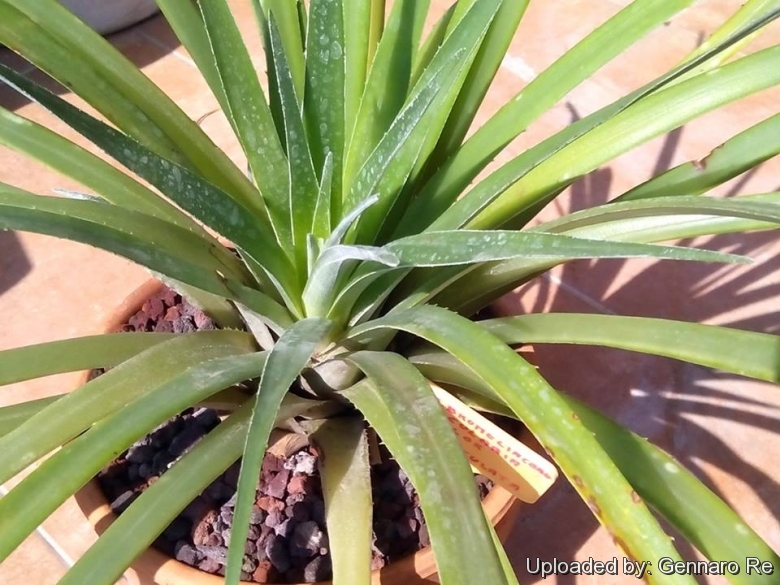
Fascicularia bicolor subs. canaliculata Photo by: Gennaro Re
Origin and Habitat: Chile South (Los Lagos). Type Locality: Valdivia, La Union, Llancucura. This plant comes from south-central coastal Chile and is considered to have the most southern distribution in the Bromeliad family. It has naturalised in parts of Florida, in Ireland, on the Isles of Scilly and in parts of western France.
Habitat and ecology: Fascicularia pitcairnifolia or Fascicularia bicolorSN|34388]]SN|34388]] subsp.canaliculata grows in the temperate forests, often under shady conditions and sometimes growing epiphytic, which means it grows on trees. By the other hand Fascicularia bicolor with conspicuously more succulent leaves grows terrestrial, is saxicolous, which means it grows on rocky ground. It grows largely in more open habitats, often on the coast and is hardier than F. bicolor ssp.canaliculata.
Synonyms:
See all synonyms of Fascicularia bicolor
Common Names include:
SPANISH (Español): Puñeñe, chupón, Chupalla, calilla, poe
Description: Fascicularia bicolorSN|34388]]SN|34388]] ssp. canaliculata (aka Fascicularia pitcairniifoliaSN|34388]]SN|34403]]) is an evergreen epiphytic or terrestrial bromeliad to 60 cm tall with rosettes holding arching soft spine-margined, strappy leaves that reach out to 90(-100) cm long, and are green on the upper surface and silvery white below. When plant flowers the center of the rosette turn scarlet surrounding the dense cluster of striking blue flowers tipped with bright yellow pollen. Each rosette may persist for many years; they do not die after flowering, but an individual rosette will only produce one inflorescence. It is not a true succulent but it is a xerophyte which means it adapted to live in dry areas.
Leaves: Green, innermost turning scarlet or red when rosette is in bloom, blade strap-like 25-90 (-130) cm long, (6-)8-11 mm wide, not markedly succulent towards base, adaxial (upper) surface distinctly channelled especia1ly below middle towards the leaf base, margins distinctly recurving.
Inflorescence: 4-5.5 cm long, 4-6.5(-8) cm in diameter; bracts (2.2)3-3.8 cm long.
Flowers: (2.2-)3.3-4.4 cm long, pale blue to blue.
Taxonomic notes: There is a lot of confusion over the names of Fascicularia pitcairnifolia and Fascicularia bicolorSN|34403]]SN|34388]]. Fascicularia pitcairniifoliaSN|34388]]SN|34403]] (often seen as "pitcairniaefolia" or "pitcairnifolia") has now been renamed Fascicularia bicolor subsp. canaliculata, and Fascicularia bicolorSN|34403]]SN|34388]] is now Fascicularia bicolorSN|34388]]SN|34388]] subsp. bicolor. The name "pitcairniifolia" should not be used because it is "ill defined" but it is still used in horticulture. F. bicolor has leaves which are shorter, thicker and more succulent and the pale blue tubular flowers subtended by ivory-colored bracts that develop fully starting from the outside with the inner flowers opening last. F. bicolor subsp.canaliculata has longer, toothed leaves and deep blue flowers which open from the centre outwards.
Subspecies, varieties, forms and cultivars of plants belonging to the Fascicularia bicolor group
- Fascicularia bicolor (Ruiz & Pav.) Mez: has leaves which are shorter, thicker and more succulent and the pale blue tubular flowers develop fully starting from the outside with the inner flowers opening last.
 Fascicularia bicolor subs. canaliculata E.C.Nelson & Zizka: has longer, toothed leaves and deep blue flowers which open from the centre outwards. Distribution: Chile South (Los Lagos).
Fascicularia bicolor subs. canaliculata E.C.Nelson & Zizka: has longer, toothed leaves and deep blue flowers which open from the centre outwards. Distribution: Chile South (Los Lagos).
Bibliography: Major references and further lectures
1) Smith, L.B. & Downs, R.J. 1979. "Fascicularia". in "Flora Neotropica" 14: 1711-1715.
2) Zizka, G.; Hones. R.; Nelson, E.C. & Weising, K. 1999. "Revision of the genus Fascicularia Mez (Bromeliaceae)". Botanical Journal of the Linnean Society 129: 315-332.
3) Nelson etZizka, "Fascicularia (Bromeliaceae): which species are cultivated and naturalized in northwestern Europe?" New-Plantsman 1997 (PDF Download Available). Available from: https://www.researchgate.net/publication
4) Fascicularia bicolor ssp. canaliculata in: "Senckenbergiana biologica", Volume 85, Senckenbergischen Naturforschenden Gesellschaft, 2005
5) Fascicularia bicolor in: East Anglian Garden Group, web: http://eastangliangardengroup.onesuffolk.net/assets/SeasonalTreasures/Fascicularia-bicolour-3.pdf
6) Fascicularia pitcairnifolia, San Marcos Growersm retrieved on 06 September 2017 from https://www.smgrowers.com/products/plants/plantdisplay.asp?plant_id=627
7) David H. Benzing, "Bromeliaceae: Profile of an Adaptive Radiation", Cambridge University Press, 06 April 2000
8/236023467_Fascicularia_Bromeliaceae_which_species_are_cultivated_and_naturalized_in_northwestern_Europe [accessed Sep 10, 2017].
 Fascicularia bicolor subs. canaliculata Photo by: Gennaro Re
Fascicularia bicolor subs. canaliculata Photo by: Gennaro ReSend a photo of this plant.The gallery now contains thousands of pictures, however it is possible to do even more. We are, of course, seeking photos of species not yet shown in the gallery but not only that, we are also looking for better pictures than those already present.
Read More... Cultivation and Propagation: Fascicularia bicolorSN|34388]]SN|34388]] is easy to grow, and is perhaps hardier than realized. Plants readily produce offsets so that large clonal colonies are easily established, and these can apparently be very long-lived. Plant in full sun to medium shade. It has low water needs and is frost and cold hardy to about -10 degrees Celsius. In Europe of course it can be grown in the ground. Both these two Fascicularia subspecies need stony ground with plenty of grit which does not get wet. They will slowly grow into large mounds of rosettes. They can also be grown in a large pot and would be quite happy if allowed to get pot bound. They look good grouped with other succulents. It is possible to grow it on the edge of a roof. Of course to do this you need to make sure you have the epiphytic form.
It a great plant for under live trees; never needs to be irrigated, but the fallen leaves get trapped in it and look unsightly; removing them is a painful job. Although the foliage appears spiny they are not wicked and can be safely planted along pathways.
Propagation: Offsets or division larger clumps. The trouble is the hooked teeth of the leaves on them and they may be vicious.










